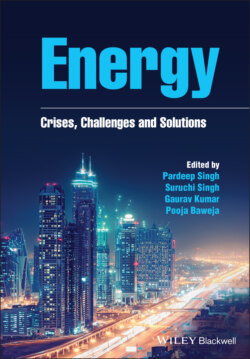Читать книгу Energy - Группа авторов - Страница 28
2.1 Introduction
ОглавлениеEnergy is regarded as an essential and crucial commodity for the economic growth of a country and more importantly for developing nations. Energy resources whether renewable or non‐renewable are consumed to generate electricity to meet the energy demand of a nation (Sorrell 2015). At present, main sources of energy are fossil fuels, namely coal, natural gas and petroleum‐based fuels (Balat 2007; Abas et al. 2015). Identification of non‐renewable energy sources and past, present and future of these energy sources are exhaustively studied. Industrial revolution has exploited these resources at a rapid rate. Extensive use of these energy resources leads to increase in CO2 amount on earth. Non‐renewable energy sources dependency poses a threat on the earth's environment which ultimately leads to negative impact on global climate (Martins et al. 2019). Further, current consumption of fossil fuels and their continuously increasing demand also endanger biodiversity on the earth (Harfoot et al. 2018). There is a huge pressure on existing energy resources due to exponential increase in the world population. Looking at the reserves of the non‐renewable energy resources (Zou et al. 2016) and to achieve the goal of energy sustainability in future, use of renewable energy sources seems to be a viable solution (Güney 2019). So, it becomes important to develop new methods to harness energy from the renewable sources of energy. Further, due to enormous exploitation of conventional resources, a worldwide competition has started for energy production from the renewable energy sources (Ellabban et al. 2014). However, in the past many questions were raised on utility and effectiveness of the renewable energy sources. Can these energy resources really supersede the non‐renewable energy sources (York 2012; Stuermer and Schwerhoff 2015)? Looking at energy conversion efficiency of the alternative sources of energy (Yaramasu et al. 2015; Ma et al. 2018; Sahli et al. 2018), it can be realized that these energy sources have a long way to go before replacing fossil fuels as source of energy.
In recent times, worldwide potential research is going in the field of alternative sources of energy. New technologies are evolving to increase the energy conversion efficiency, reduce the cost of power production and feasibility for large‐scale production in nearly all the renewable energy sources sectors i.e. solar (Kannan and Vakeesan 2016; Pandey et al. 2016), wind (IRENA 2019a), hydro (Kougias et al. 2019), geothermal (Olasolo et al. 2016), bioenergy (IRENA 2019b) and ocean energy (Wilberforce et al. 2019). Technologies in the solar and wind energy sector are growing at a faster rate compared with other alternative sources of energy. One of the paradigm shifts in solar energy usage is conversion of CO2 into fuels and highly valued chemicals (He and Janáky 2020). Such advances will have dual benefits i.e., generating fuels using CO2 which is a threat to environment and utilizing the renewable solar energy. Further, solar energy is also exploited to resolve the freshwater crises via advanced evaporation systems (Xu et al. 2020). Harnessing onshore and offshore wind energy can become competitive to power generation from the non‐renewable energy sources due to evolution of new and innovative technologies in the wind energy sector (IRENA 2019a).
